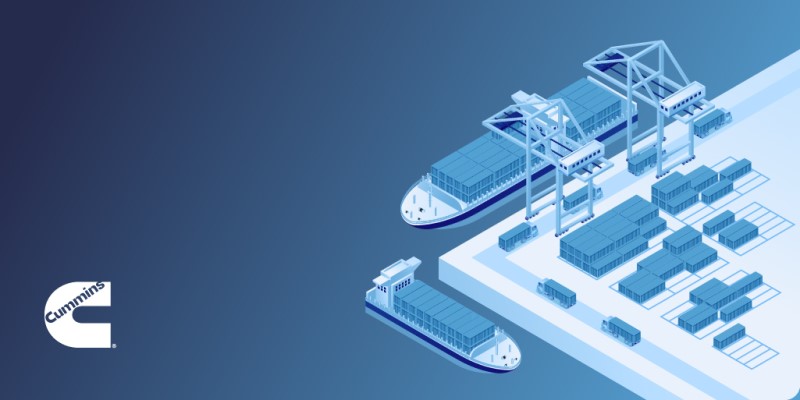How software containerization advances commercial vehicle software compatibility
By Cummins Inc., Global Power Technology Leader

For customers to fully optimize their fleets, they need the latest software capabilities coupled with the best engine and powertrain technologies. Cummins Inc. has a long history of innovation in telematics technologies that enhance fleet efficiency by increasing uptime and streamlining maintenance and repair. Cummins Inc. has a long history of innovation in telematics technologies and customizing and integrating software with original equipment manufacturers (OEMs). Such expertise has enhanced fleet efficiency through increased uptime and streamlined maintenance and repair events.
With so many different software and telematics platforms being used by OEMs, integration has become increasingly complex and inefficient. Adopting software containerization standards such as the Open Telematics Framework reinforces Cummins’ commitment to providing cutting-edge, reliable and innovative solutions for the industry that reduce integration costs and increase compatibility.
Cummins Inc. has found remarkable success in using the cold testing method to test its turbochargers.

What is software containerization?
Software containerization gets its name from the shipping container standard developed in the late 1950s to increase the efficiency of transporting goods. By adopting a standard size and interface, any shipping container can be moved by cargo ships, railroad cars and semi-trucks. This standardization sped up the loading, unloading and distribution of products. Software containers achieve similar outcomes. But what does this look like for software?
Software containers are built around the OCI (Open Container Initiative) standard developed by companies such as Amazon, Google and Docker. This standard allows developers to bundle all application components into a single OCI-compliant container. This standard OCI container can run on any device that supports OCI, eliminating the customization of the past required to make applications compatible. This approach allows Cummins to create applications, such as Connected Software Update, once, with the ability to reuse them across numerous OEM telematics devices.
The Open Telematics Framework initiative helps establish a common, open-source framework for developing the next generation of commercial vehicle software, incorporating standard connections, interfaces and cybersecurity components.
What are the benefits of software containerization?
Ease of implementation and cost savings through scalability
Most OEMs have multiple telematics platforms in production. Often, OEMs switch telematics suppliers or choose different suppliers for each global region they operate in. In the past, each telematics platform required developing a completely customized set of applications. This made application maintenance time-consuming, complex and expensive.
Through software containerization, OEMs can benefit by adopting a single application standard that can be reused across all their telematics hardware variations. This standard also makes it significantly easier to integrate other third-party software into their telematics platforms.
Accelerated time to market from simplified development
The journey from concept to market is faster and smoother with containerized software, which eliminates the need for extensive customization. Leveraging a standardized approach shifts the focus from managing complex development efforts to ensuring that products reach the market sooner.
Access to next-generation features
In an era where technological obsolescence is a constant threat, containerized software ensures that products and services remain at the forefront of innovation, fully compatible with emerging trends and technologies. Containerization streamlines software updates to equip customers with the latest features and functionalities, making their operations not just current but also future-ready.
Why is the Cummins Open Telematics Framework essential for the transportation industry?
With over one hundred years of expertise in the industry, Cummins is constantly innovating for customers and driving the industry forward, solving critical industry-wide challenges. Software containerization promotes increased portability and scalability, allowing more customers to use software faster and easier with a lower cost.
Through the Eclipse Software Defined Vehicle Project, Cummins is joining forces with Microsoft and industry leaders to build Open Telematics Framework, a cutting-edge framework that revolutionizes telematics and the next generation of commercial vehicles. Through the partnership, Microsoft handles the delivery of Cummins-developed applications as an option available to Eclipse Software Defined Vehicle Project members, which include other automotive and technology companies like General Motors, Mercedes Benz, Qualcomm, Redhat and T-Systems.
Transitioning to containerization ensures customers that their products and services are fully compatible with future technology in the industry. With every advancement in the industry, the Open Telematics Framework advances with them.
Author Profiles

Cummins Inc., Global Power Technology Leader
Cummins Inc., a global power leader, is committed to powering a more prosperous world. Since 1919, we have delivered innovative solutions that move people, goods and economies forward. Our five business segments—Engine, Components, Distribution, Power Systems and Accelera™ by Cummins—offer a broad portfolio, including advanced diesel, alternative fuel, electric and hybrid powertrains; integrated power generation systems; critical components such as aftertreatment, turbochargers, fuel systems, controls, transmissions, axles and brakes; and zero-emissions technologies like battery and electric powertrain systems and electrolyzers. With a global footprint, deep technical expertise and an extensive service network, we deliver dependable, cutting-edge solutions tailored to our customers’ needs, supporting them through the energy transition with our Destination Zero strategy. We create value for customers, investors and employees and strengthen communities through our corporate responsibility global priorities: education, equity and environment. Headquartered in Columbus, Indiana, Cummins employs approximately 70,000 people worldwide and earned $3.9 billion on $34.1 billion in sales in 2024.
Related Topics
Related Tags